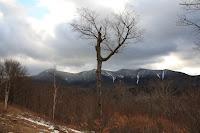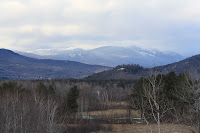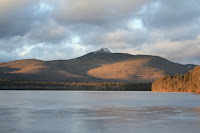Always being mindful of responsible, safe hiking practices is one of the best New Year's
resolutions that we can think of. Check out this new video from the New Hampshire
Outdoor Council, highlighting hikeSafe.
"hikeSafe: It's your responsibility" highlights the experiences of three avid hikers and the
lessons they have learned in the mountains of New Hampshire. Though the mountains are
beautiful -- and hiking can be incredibly fun -- the mountains must also be respected, and
hiking must be approached with full understanding of its demands. These hikers share
their knowledge, sometimes earned through discomfort and even danger. Whether lost
alone on a wilderness trail, buffeted by icy ridge-top gales, or forced to spend an
unplanned night out by a raging river, the hikers speak earnestly and candidly so that
others may benefit. The hikers stress the hikeSafe responsibility code, which encourages
outdoor enthusiasts to be fully prepared for the challenges of the outdoors.
their knowledge, sometimes earned through discomfort and even danger. Whether lost
alone on a wilderness trail, buffeted by icy ridge-top gales, or forced to spend an
unplanned night out by a raging river, the hikers speak earnestly and candidly so that
others may benefit. The hikers stress the hikeSafe responsibility code, which encourages
outdoor enthusiasts to be fully prepared for the challenges of the outdoors.
Preparing for your hike:
There are twelve "must have" items when you go for
hike, even if it is in familiar territory and only for a short time in perfect
weather. There are another ten optional items that you should carry when
you are hiking. No equipment list is perfect. Keep in mind that if
you are going for a day hike in the Painted Desert in July, your needs will be
much different then going on a day hike in the Garden of The Gods State Park,
In Colorado, or Acadia National Park in Maine.
The twelve "must have" items should be carried at all
times. It may seem ridiculous to carry rain gear in a desert, but if that
sudden shower were to come up, you will be glad to have it. You may have
hiked an area one-hundred times and know it like the back of your hand -- but
find out about an unexpected trail closure, and you will be wishing you had a map.
Naturally you will also need a pack to carry your equipment
in. A well thought out packing and equipping job can allow the hiker to hold the twelve
essentials in a small fanny pack. If you are hiking in
special conditions like cold weather (which will require bulkier gear) then a
day pack may be required. High quality day packs can be had for $50 to
$75. Generally if you spend less than that on a day pack, you are risking
getting a lower quality product, or worse one that beats you to death when
hiking.
Number one, a plan. You should never hike without a plan. You should
plan your route, check the local weather, get trail conditions, and notify a
friend, relative, neighbor, or ranger of your plans. If there are
trailhead registers on the trail you should use them. Try to stick to
your plan.
Number two, a map. Even if you have hiked a trail a hundred times, you
should carry a map. Unexpected trail closures, an injury requiring a
shorter route, bad weather, or animal encounter can all result in a sudden
change of plans. Having a map assists in this greatly. You don't
have to carry topographical maps for a regular day hike. Practically
every state and national park provides hiking maps of trails and features for
free or a nominal fee. Some of the best maps I have ever used are provided at most trail-heads and parking lots, and they are
some of the most low tech maps you will ever use.
Number three, a compass. Carrying a compass with you is not enough, you need to
know how to use it properly. Adjustments for declination, field
interference, the metal on your equipment, and poor handling can make a compass
a dangerous tool to use. You should find a good orienteering class and
take it to learn about using a compass in the field. If you do not have
experience with a compass, you should stay away from lensatic models (ones with
a flip up view finder) until you have more experience, and further they don't
work very well when overlaid on a map.
Number four, a pocket knife. I am partial to the Swiss Army style
knives, but almost any kind of pocket knife will do. You should keep your
blade length around three inches and the knife should have a locking
blade. A pocket knife can have a million uses in the field as the need
arises. You should carry your pocket knife on your person, and not in
your pack.
Number five, a whistle. A good survival whistle is essential to carry when
hiking. The sound a whistle makes travels much further then your voice
ever could in an emergency situation. When walking through bear country
you can blow on it to alert the bears that you are passing through. You
can also use it to communicate with others in your group, say some one is too
far ahead, or falling behind. A whistle can be the best $2.00 to $7.00
piece of hiking safety equipment you will spend. You should always carry
your whistle around your neck, and not in your pack.
Number six, a personal first aid kit. A good first aid kit does not have to
be large, elaborate, or expensive. The basic kit should include
antiseptic wipes, sting relief, burn cream, band-aids of various types and
sizes, cotton balls, sterile pads, gauze, tape, pain reliever (a.k.a. aspirin
or Tylenol), antacid (tablets), Benadryl (tablets), mole skin (for blisters),
one pair of latex gloves, and tweezers.
If you are hiking in an area with a large poisonous snake population and will be more than one hour away from help you should also carry a basic snake bite kit but only after receiving proper instruction on it's use. A snake bite kit in the wrong hands can cause more damage then the actual bite.
Oral Benadryl should be carried for insect bites or stings. If yourself or a person in your party has never had an insect sting before (a.k.a. bee, wasp, hornet) the Benadryl can be administered to slow down an allergic reaction, but medical attention should be sought out at the first sign of a severe reaction.
If you are hiking in an area with a large poisonous snake population and will be more than one hour away from help you should also carry a basic snake bite kit but only after receiving proper instruction on it's use. A snake bite kit in the wrong hands can cause more damage then the actual bite.
Oral Benadryl should be carried for insect bites or stings. If yourself or a person in your party has never had an insect sting before (a.k.a. bee, wasp, hornet) the Benadryl can be administered to slow down an allergic reaction, but medical attention should be sought out at the first sign of a severe reaction.
Number seven, a flashlight with spare batteries. The large lantern style flashlight has been replaced by micro flashlights with alloy skins, xenon bulbs, and a battery life of eight hours on two AA batteries. You should carry a flashlight with you regardless of the time of day your are hiking or your plans. A severe storm can require you to stop while you wait for it to pass. What would you do if night fell and you did not have any light. It is also essential to carry spare batteries that are known to be fresh. A good, reliable, compact, waterproof flashlight can be purchased for under $20.
Number eight, waterproof matches. Carrying waterproof matches is done to expect the unexpected. If you become lost, delayed, or injured, a day hike can turn into an overnight stay in the wilderness. Accidentally fall into an icy river, or get pelted by an unexpected rain storm, your ability to make a fire to warm up may mean the difference between life and death. Genuine waterproof matches should be carried. If you transfer your matches to a match holder, be sure that you have a surface to strike the match on if a special surface is required. A cigarette lighter is not a good substitute for matches, but can be carried as an alternative source of flame. If you want to feel truly prepared, you can carry a flint and steel kit with some cotton and cork for fire starting as a third backup.
Number nine, emergency rain gear. Your equipment does not have to be elaborate. A simple poncho left in it's store packaging is more than adequate for most regions of North America for three season hiking. If you are hiking at high altitude, in an area that is prone to rain a lot (the Northwestern United States, New England coast, Northwestern Colorado, Southeastern United States in the spring and summer) or where the temperature will be below 60 degrees, more adequate rain gear should be carried. If you are caught in a sudden shower you should cover up in your poncho, and wait for it to pass. Make sure you are not standing in a dry riverbed or wash while waiting. If you are caught in a thunderstorm you should move away from high ground and tall objects (like trees) immediately. Find a low spot, ravine, or thin place in the woods, cover up with your poncho, stay low and wait for it to pass.
Number ten, insect repellent and/or sunscreen. The joy of hiking, fresh air, scenic vistas, ticks, chiggers, mosquitoes, and sunburn. Insect repellant and sunscreen are vital to carry when hiking.
When using insect repellant it is best to treat your clothing with a spray before entering the field, and to use a cream based repellant on any exposed skin upon entering the field. Cream based repellants pack better and take up less room. A variety that contains anywhere from 20% to 35% DEET should be effective in most cases. DEET masks carbon-dioxide which most biting insects use to detect their next victim. DEET in high concentrations (a.k.a. 100%) and used over extended periods of time in large doses has been proven to cause medical side effects. You should use insect repellant sparingly and if you are pregnant you should consult with your physician.
If you also use sunscreen, you should use a low scent/no scent variety. The perfumes that are put into sunscreen will only attract insects, and worse may attract bears. No Ad sunscreen which can be found at Wal-Mart is an excellent product for it's ability to protect, be waterproof, and have virtually no odor. It also happens to be very inexpensive.
There are a number of combination products appearing on the market today that act both as sunscreen and as insect repellant. Off brand is the most popular and these products work moderately well. At the time of preparing this article, there was no independent data on the effectiveness of these combination products when compared to their stand alone counterparts. Further, there is no real data on using separate sunscreen and insect repellant at the same time. You should draw your own conclusions and use what works best for you.
When using insect repellant it is best to treat your clothing with a spray before entering the field, and to use a cream based repellant on any exposed skin upon entering the field. Cream based repellants pack better and take up less room. A variety that contains anywhere from 20% to 35% DEET should be effective in most cases. DEET masks carbon-dioxide which most biting insects use to detect their next victim. DEET in high concentrations (a.k.a. 100%) and used over extended periods of time in large doses has been proven to cause medical side effects. You should use insect repellant sparingly and if you are pregnant you should consult with your physician.
If you also use sunscreen, you should use a low scent/no scent variety. The perfumes that are put into sunscreen will only attract insects, and worse may attract bears. No Ad sunscreen which can be found at Wal-Mart is an excellent product for it's ability to protect, be waterproof, and have virtually no odor. It also happens to be very inexpensive.
There are a number of combination products appearing on the market today that act both as sunscreen and as insect repellant. Off brand is the most popular and these products work moderately well. At the time of preparing this article, there was no independent data on the effectiveness of these combination products when compared to their stand alone counterparts. Further, there is no real data on using separate sunscreen and insect repellant at the same time. You should draw your own conclusions and use what works best for you.
Number eleven, water. Water is essential when you are hiking. For every two hours you plan to spend hiking you should carry at least one quart of water. For a full day you should carry a gallon. There are a number of solutions for carrying water. Simple one quart water bottles can be found almost anywhere on the internet or in a store for just a couple of dollars. Hydration systems, backpacks with a water bladder and a bite valve can also be used. Camelbak makes a very popular hydration system that holds one-hundred ounces of water (about 3 quarts, 1 cup) that runs anywhere from $60 to $80. These hydration systems offer many benefits but may complicate your ability to carry a pack. You also need to keep in mind that your water supply will be the heaviest thing you carry on a day hike. A gallon of water weighs close to nine pounds!
Number twelve, food. Food is also essential when you are hiking. Not only does eating food on the trail help keep your system balanced, it provides a cushion if there is an emergency. Complex carbohydrates and proteins make the best food to carry. Dried fruits, jerky, nuts, peanut butter, whole grain mini bagels, prepared energy bars, candy bars with a high protein content (nuts, peanut butter) and crackers make excellent field rations for a day hike. A self opening single serving can of tuna, a mayo packet, and some creative mixing in a plastic bag can make for a compact and good meal. Raisins and peanut butter on a bagel is also an excellent energy fix. You should try to carry at least 2,000 calories worth of food when hiking. Also, you should double pack your rations in plastic bags and remember to carry out all trash. If you drop food on the ground by accident you should pick it up and pack it out.























































